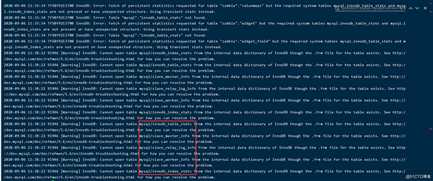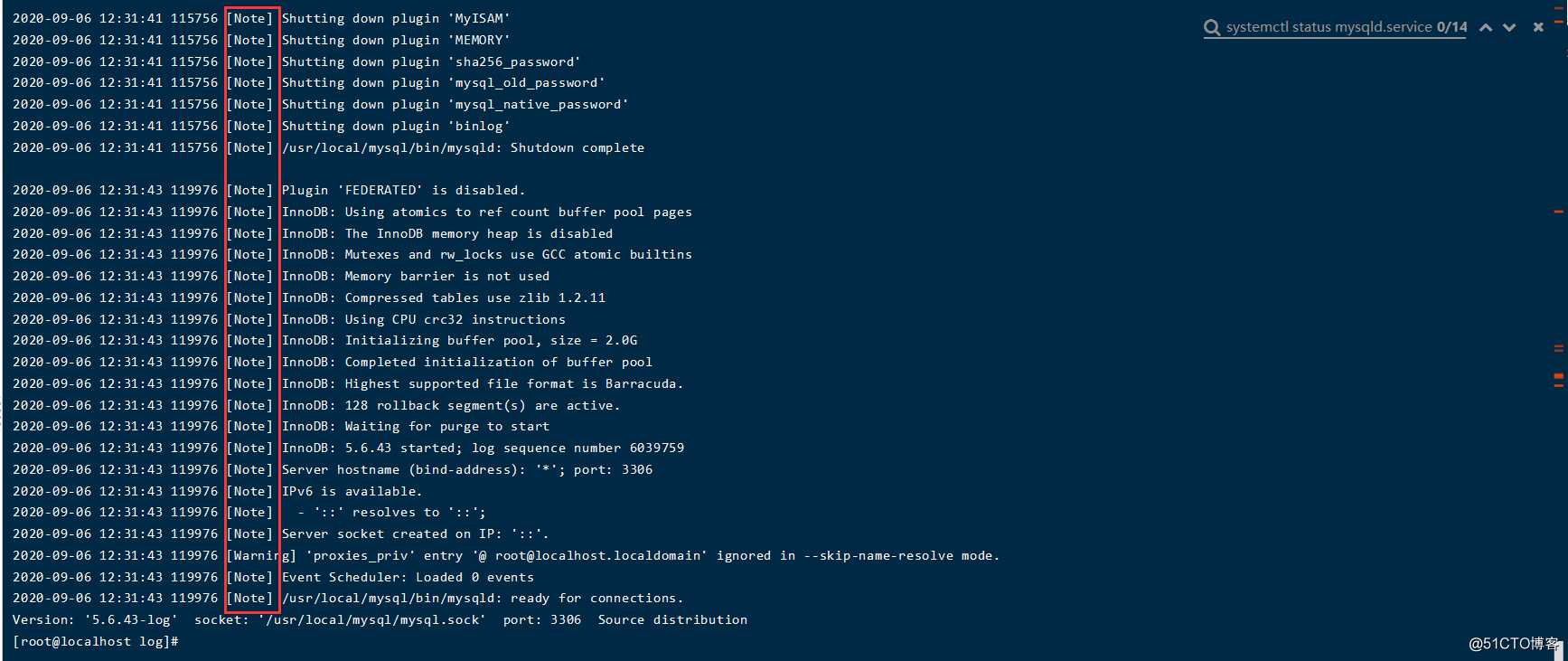一、 通过系统命令查看proxy状态原以为一切正常,但仔细查看zabbix有关服务时,却没有发现发现相应的proxy端口在使用。如图1、2.
图1

图2
那实际上zabbix_proxy是没在工作的。
二、 对其日志文件进行查看,如图3.查看命令:tail -n 1000 zabbix_proxy.log #筛选最新的1000行数据进行查看。
图3
从最新的几行报错可以出看是数据库连接失败引起的问题。
三、 查看数据库状态,图4.
图4
四、 查看指定目录下的是否有对应sock文件,图5
图5
没该文件。
五、 查看数据库报错日志error.log(查看命令使用了“tail -n 1000 error.log”),图6 #如果不清楚位置可使用命令 find / -name error.log 进行全局查找.
图6
可以尝试在my.cnf中配置相应的参数(>0),而打开数据库。
六、 配置数据库配置文件my.cnf,增加一行innodb_force_recovery = 1 ,如图7
图7
innodb_force_recovery
级别 含义
1 (SRV_FORCE_IGNORE_CORRUPT)忽略检查到的corrupt页
2 (SRV_FORCE_NO_BACKGROUND)阻止主线程的运行,如主线 程需要执行full purge操作,会导致crash
3 (SRV_FORCE_NO_TRX_UNDO)不执行事务回滚操作。
4 (SRV_FORCE_NO_IBUF_MERGE)不执行插入缓冲的合并操作。
5 (SRV_FORCE_NO_UNDO_LOG_SCAN)不查看重做日志,InnoDB存储引擎会将未提交的事务视为已提交
6 (SRV_FORCE_NO_LOG_REDO)不执行前滚的操作。
七、 重新启动数据库,再去查看数据库日志(error.log),图8.
图8
存在该部分错表。
八、 登录数据库,删除错表,图9
mysql>DROP TABLE mysql.innodb_index_stats;
mysql>DROP TABLE mysql.innodb_table_stats;
mysql>DROP TABLE mysql.slave_master_info;
mysql>DROP TABLE mysql.slave_relay_log_info;
mysql>DROP TABLE mysql.slave_worker_info;
图9
未找到该表。
九、 关闭数据库,删除旧文件,图10,图11
rm -rf /data/mysql/data/mysql/innodb_index_stats.*
rm -rf /data/mysql/data/mysql/innodb_table_stats.*
rm -rf /data/mysql/data/mysql/slave_master_info.*
rm -rf /data/mysql/data/mysql/slave_relay_log_info.*
rm -rf /data/mysql/data/mysql/slave_worker_info.*
图10
图11
十、 打开数据库,重新构建数据库表,
如下执行内容共5条,一条一条地复制执行即可: 图12为其中一条的执行结果。
USE mysql;
1.
CREATE TABLE innodb_index_stats (
database_name varchar(64) COLLATE utf8_bin NOT NULL,
table_name varchar(64) COLLATE utf8_bin NOT NULL,
index_name varchar(64) COLLATE utf8_bin NOT NULL,
last_update timestamp NOT NULL DEFAULT CURRENT_TIMESTAMP ON UPDATE CURRENT_TIMESTAMP,
stat_name varchar(64) COLLATE utf8_bin NOT NULL,
stat_value bigint(20) unsigned NOT NULL,
sample_size bigint(20) unsigned DEFAULT NULL,
stat_description varchar(1024) COLLATE utf8_bin NOT NULL,
PRIMARY KEY (database_name,table_name,index_name,stat_name)
) ENGINE=InnoDB DEFAULT CHARSET=utf8 COLLATE=utf8_bin STATS_PERSISTENT=0;
2.
CREATE TABLE innodb_table_stats (
database_name varchar(64) COLLATE utf8_bin NOT NULL,
table_name varchar(64) COLLATE utf8_bin NOT NULL,
last_update timestamp NOT NULL DEFAULT CURRENT_TIMESTAMP ON UPDATE CURRENT_TIMESTAMP,
n_rows bigint(20) unsigned NOT NULL,
clustered_index_size bigint(20) unsigned NOT NULL,
sum_of_other_index_sizes bigint(20) unsigned NOT NULL,
PRIMARY KEY (database_name,table_name)
) ENGINE=InnoDB DEFAULT CHARSET=utf8 COLLATE=utf8_bin STATS_PERSISTENT=0;
3.
CREATE TABLE slave_master_info (
Number_of_lines int(10) unsigned NOT NULL COMMENT ‘Number of lines in the file.‘,
Master_log_name text CHARACTER SET utf8 COLLATE utf8_bin NOT NULL COMMENT ‘The name of the master binary log currently being read from the master.‘,
Master_log_pos bigint(20) unsigned NOT NULL COMMENT ‘The master log position of the last read event.‘,
Host char(64) CHARACTER SET utf8 COLLATE utf8_bin NOT NULL DEFAULT ‘‘ COMMENT ‘The host name of the master.‘,
User_name text CHARACTER SET utf8 COLLATE utf8_bin COMMENT ‘The user name used to connect to the master.‘,
User_password text CHARACTER SET utf8 COLLATE utf8_bin COMMENT ‘The password used to connect to the master.‘,
Port int(10) unsigned NOT NULL COMMENT ‘The network port used to connect to the master.‘,
Connect_retry int(10) unsigned NOT NULL COMMENT ‘The period (in seconds) that the slave will wait before trying to reconnect to the master.‘,
Enabled_ssl tinyint(1) NOT NULL COMMENT ‘Indicates whether the server supports SSL connections.‘,
Ssl_ca text CHARACTER SET utf8 COLLATE utf8_bin COMMENT ‘The file used for the Certificate Authority (CA) certificate.‘,
Ssl_capath text CHARACTER SET utf8 COLLATE utf8_bin COMMENT ‘The path to the Certificate Authority (CA) certificates.‘,
Ssl_cert text CHARACTER SET utf8 COLLATE utf8_bin COMMENT ‘The name of the SSL certificate file.‘,
Ssl_cipher text CHARACTER SET utf8 COLLATE utf8_bin COMMENT ‘The name of the cipher in use for the SSL connection.‘,
Ssl_key text CHARACTER SET utf8 COLLATE utf8_bin COMMENT ‘The name of the SSL key file.‘,
Ssl_verify_server_cert tinyint(1) NOT NULL COMMENT ‘Whether to verify the server certificate.‘,
Heartbeat float NOT NULL,
Bind text CHARACTER SET utf8 COLLATE utf8_bin COMMENT ‘Displays which interface is employed when connecting to the MySQL server‘,
Ignored_server_ids text CHARACTER SET utf8 COLLATE utf8_bin COMMENT ‘The number of server IDs to be ignored, followed by the actual server IDs‘,
Uuid text CHARACTER SET utf8 COLLATE utf8_bin COMMENT ‘The master server uuid.‘,
Retry_count bigint(20) unsigned NOT NULL COMMENT ‘Number of reconnect attempts, to the master, before giving up.‘,
Ssl_crl text CHARACTER SET utf8 COLLATE utf8_bin COMMENT ‘The file used for the Certificate Revocation List (CRL)‘,
Ssl_crlpath text CHARACTER SET utf8 COLLATE utf8_bin COMMENT ‘The path used for Certificate Revocation List (CRL) files‘,
Enabled_auto_position tinyint(1) NOT NULL COMMENT ‘Indicates whether GTIDs will be used to retrieve events from the master.‘,
PRIMARY KEY (Host,Port)
) ENGINE=InnoDB DEFAULT CHARSET=utf8 STATS_PERSISTENT=0 COMMENT=‘Master Information‘;
4.
CREATE TABLE slave_relay_log_info (
Number_of_lines int(10) unsigned NOT NULL COMMENT ‘Number of lines in the file or rows in the table. Used to version table definitions.‘,
Relay_log_name text CHARACTER SET utf8 COLLATE utf8_bin NOT NULL COMMENT ‘The name of the current relay log file.‘,
Relay_log_pos bigint(20) unsigned NOT NULL COMMENT ‘The relay log position of the last executed event.‘,
Master_log_name text CHARACTER SET utf8 COLLATE utf8_bin NOT NULL COMMENT ‘The name of the master binary log file from which the events in the relay log file were read.‘,
Master_log_pos bigint(20) unsigned NOT NULL COMMENT ‘The master log position of the last executed event.‘,
Sql_delay int(11) NOT NULL COMMENT ‘The number of seconds that the slave must lag behind the master.‘,
Number_of_workers int(10) unsigned NOT NULL,
Id int(10) unsigned NOT NULL COMMENT ‘Internal Id that uniquely identifies this record.‘,
PRIMARY KEY (Id)
) ENGINE=InnoDB DEFAULT CHARSET=utf8 STATS_PERSISTENT=0 COMMENT=‘Relay Log Information‘;
5.
CREATE TABLE slave_worker_info (
Id int(10) unsigned NOT NULL,
Relay_log_name text CHARACTER SET utf8 COLLATE utf8_bin NOT NULL,
Relay_log_pos bigint(20) unsigned NOT NULL,
Master_log_name text CHARACTER SET utf8 COLLATE utf8_bin NOT NULL,
Master_log_pos bigint(20) unsigned NOT NULL,
Checkpoint_relay_log_name text CHARACTER SET utf8 COLLATE utf8_bin NOT NULL,
Checkpoint_relay_log_pos bigint(20) unsigned NOT NULL,
Checkpoint_master_log_name text CHARACTER SET utf8 COLLATE utf8_bin NOT NULL,
Checkpoint_master_log_pos bigint(20) unsigned NOT NULL,
Checkpoint_seqno int(10) unsigned NOT NULL,
Checkpoint_group_size int(10) unsigned NOT NULL,
Checkpoint_group_bitmap blob NOT NULL,
PRIMARY KEY (Id)
) ENGINE=InnoDB DEFAULT CHARSET=utf8 STATS_PERSISTENT=0 COMMENT=‘Worker Information‘;

图12
执行成功。
十一、 注释掉原来配置文件的innodb_force_recovery = 1 内容,然后重启数据库,查看数据库日志是否还有报错。图13.
图13
十二、 重启zabbix_proxy然后,查看zabbix_proxy的使用端口情况。图14
图14
至此启动成功。
原文:https://blog.51cto.com/14483703/2539195